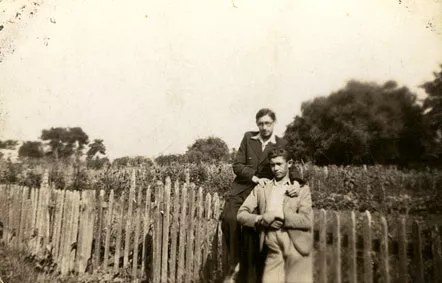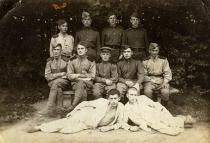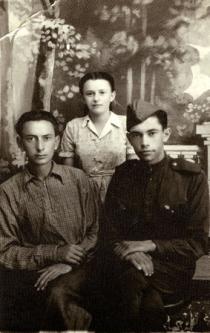This is me with some friend from Czortkow, who came to Mielnica Podolska on holidays. I can’t say nothing more, because he came only once in 1937. I even don’t remember his name. The photo was taken by some photographer in Mielnica in 1937.
I was born in a little town of Mielnica Podolska in the Tarnopol region. Altogether there were 5,000 people living there. Apart from Jews they were Poles and Ukrainians. The town itself was Jewish, but the surrounding area was mostly Ukrainian, with the occasional Poles. Well, the Ukrainians were the majority, the Jews made up less then a half of the population and there were very few Poles. The Poles just ran the offices, right. If a Pole lived in the town, he was an administrator or a warehouse manager. The policeman was Polish, the postman was Polish, they worked in the courts, or as office clerks.
Most of the Jews lived in the town. The market square, all of its surroundings were populated by Jews. Those were all old streets, no new buildings there. They were putting up new buildings but that was in the other part of the town. The market square had a small paved section but the rest was a swamp. When it rained, you could neither walk nor drive through it. There was a well in the center, right, and a pump, and that was it. Everyone stocked up on water there. There were some shops, a few little cafés. The cafés were owned by Jews, and the patrons were of course Jewish as well. I mean, the places were not exclusively for Jews, but the non-Jewish population wasn't interested in such cultured ways of spending time: to sit over a coffee or play some chess. Anyway, I was a very young boy back then before the war and that's how I recall it. The older boys hung out at the cafés to listen to the radio and drink some soda, especially on Saturdays, right. You could croon, sing a tune there, right. You might say it was the central point of the town, a typical spot for socializing. There was no synagogue at the square. And the rabbi didn't live by the square, either. Well, the fairs took place there, right, lots of horses, cows, pigs you could buy, and crops. It was a small town market. There was a mikveh in the town, but I've never been there. It was somewhere near the non-Jewish bath house.
There were two cemeteries in the town: the old one, where they wouldn't later bury anyone anymore, and the new one. Both situated on the outskirts. At the main road I guess, leading to the Iwanie Puste train station. At that time before the war those were the outskirts. I went to the old cemetery just to see how it looked like. You know, we've made a trip with the rest of the boys. And the new cemetery was only partially filled with mazevot, the graves. Neither one was particularily well kept. And anyway the Jewish cemeteries have one thing in common, they have no alleys, lanes, right. It's all saturated, one tomb right next to the other, dense.
I remember there were three synagogues in town. Two were modest and the third one was bigger and its interior was a bit more fancy. The bimah was high there and the Aron Kodesh. It was beautiful. Prettier than the other synagogues. The others were so coarse. Maybe it had something to do with the people attending the services. The Jews in town varied. The poor had the simpler synagogue and the richer gathered in the more elegant one. But I'm not that sure of it. My Grandpa went to the normal, simple synagogue.
I don't remember any conflicts in the town, but I guess there could have been some. I don't recall any great friendships, either. Townspeople of different nationalities didn't mingle with each other, didn't go to common weddings, right, or christening parties, but as for arguments or troubles - no such things either. Jews and Ukrainians didn't celebrate the Catholic holidays but neither did they stay at home. And anyway, I was only 15 in 1939 and had lots of other things on my mind, so I can't tell exactly. But I remember the town's celebrations of Corpus Christi. The summers there, in the Kresy, The Eastern Borderlands, were without rain, there were droughts. And one year was so dry the rabbi with his community, and the Orthodox priest with his community, and the Catholic priest with his processioned around the market square and beyond, praying for rain. They were all praying together.
















